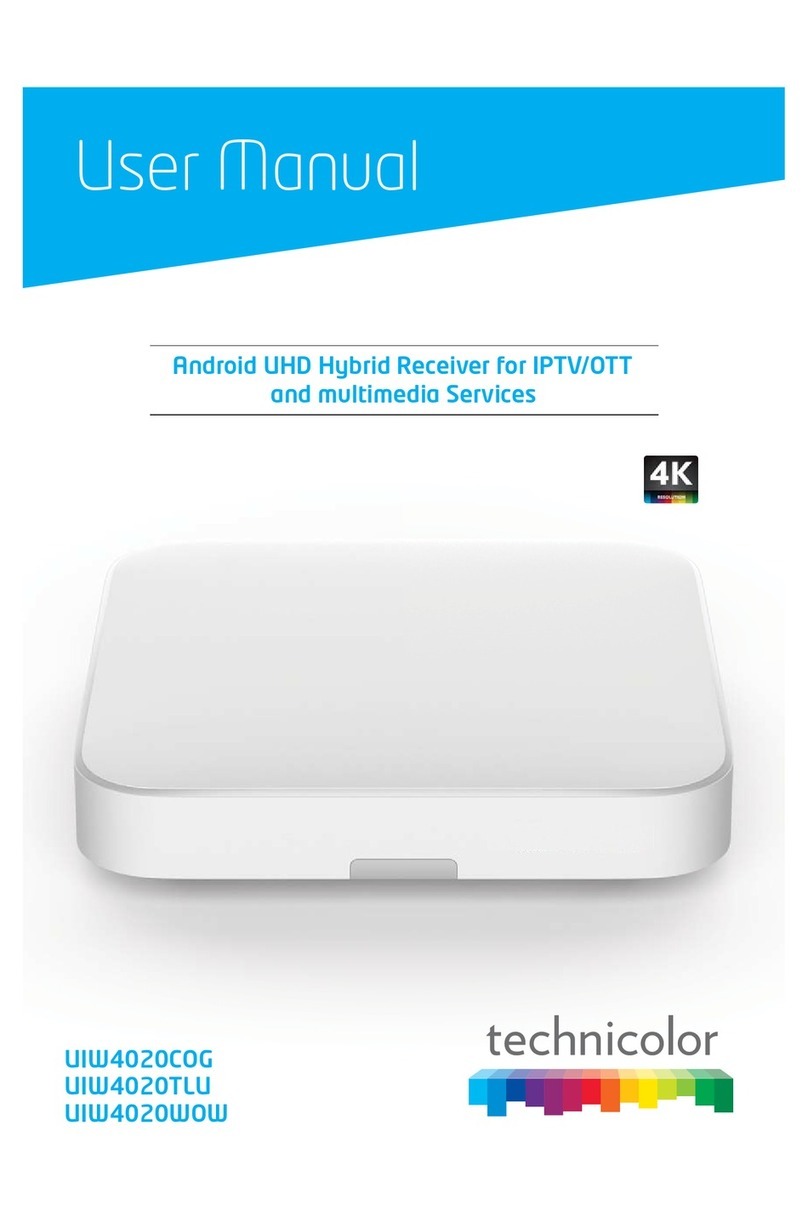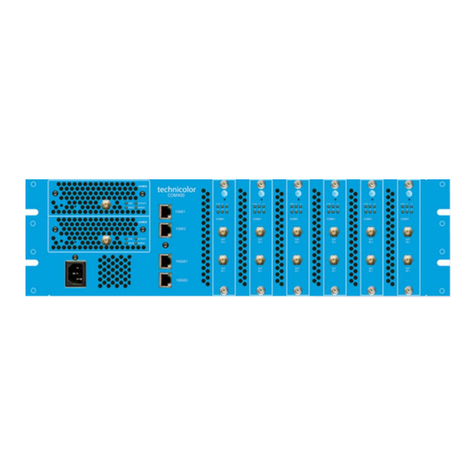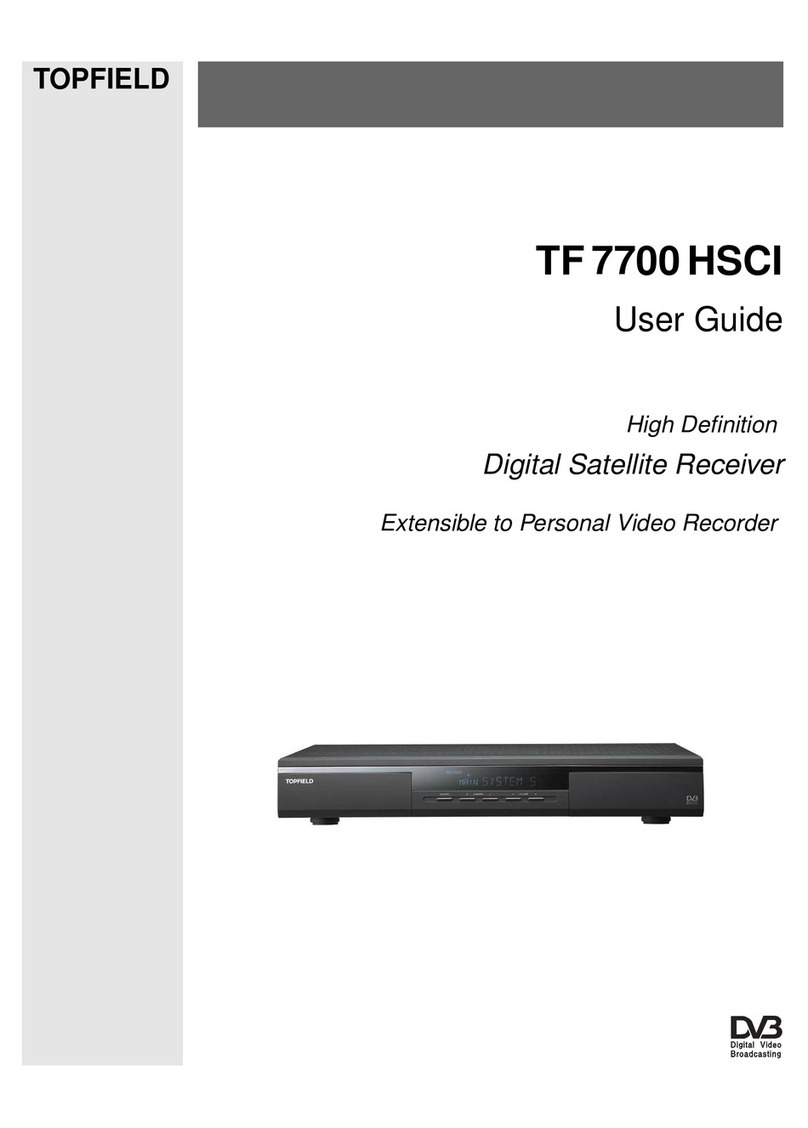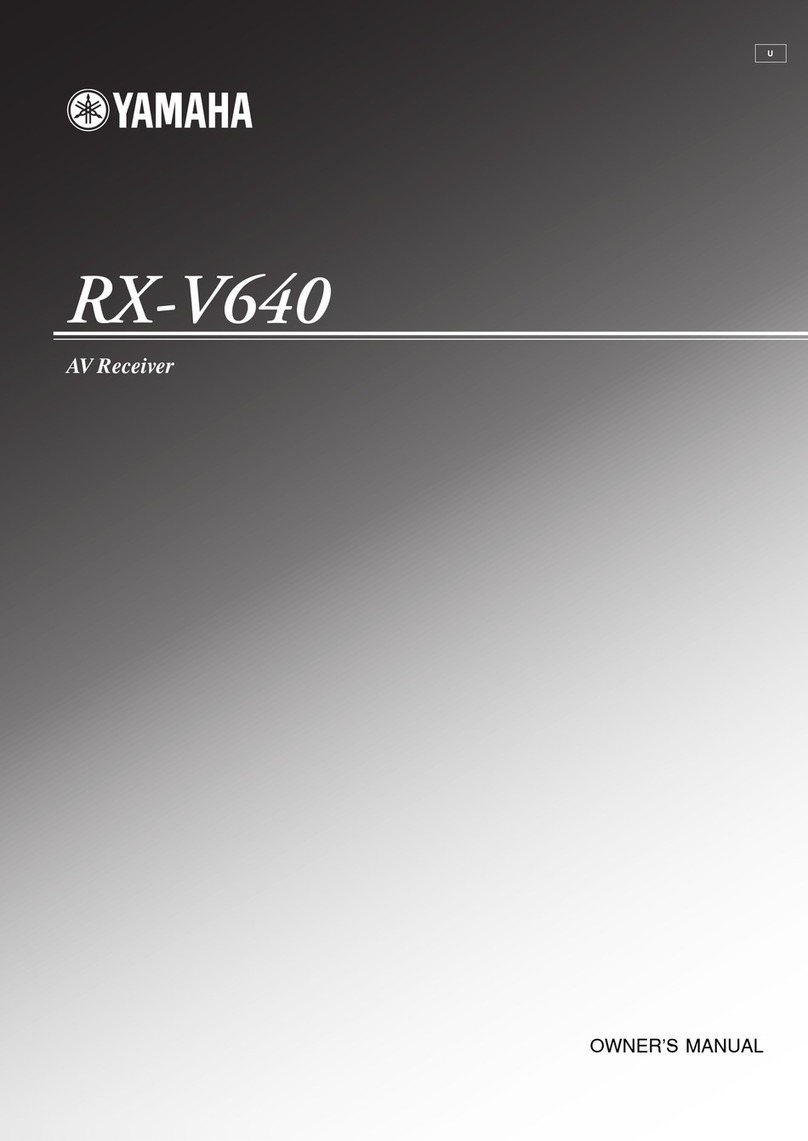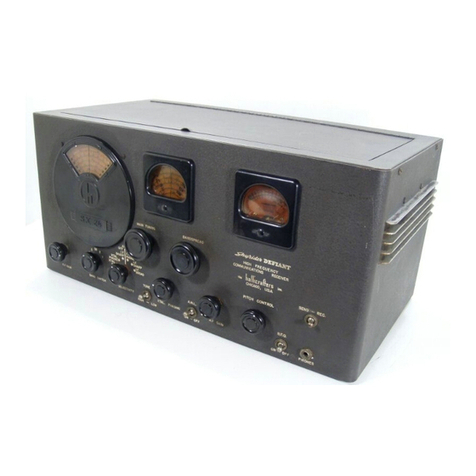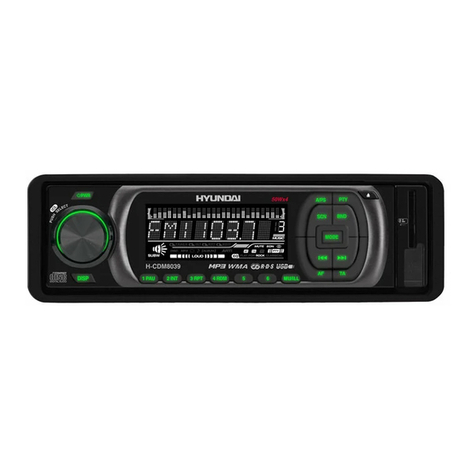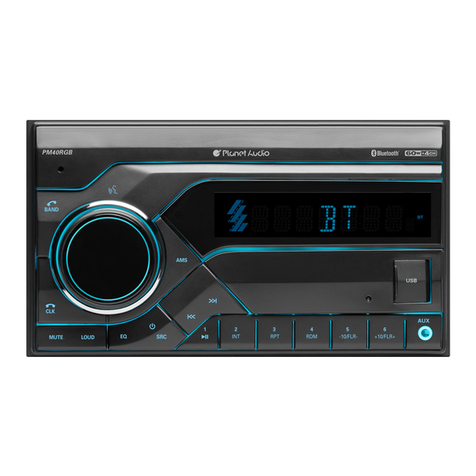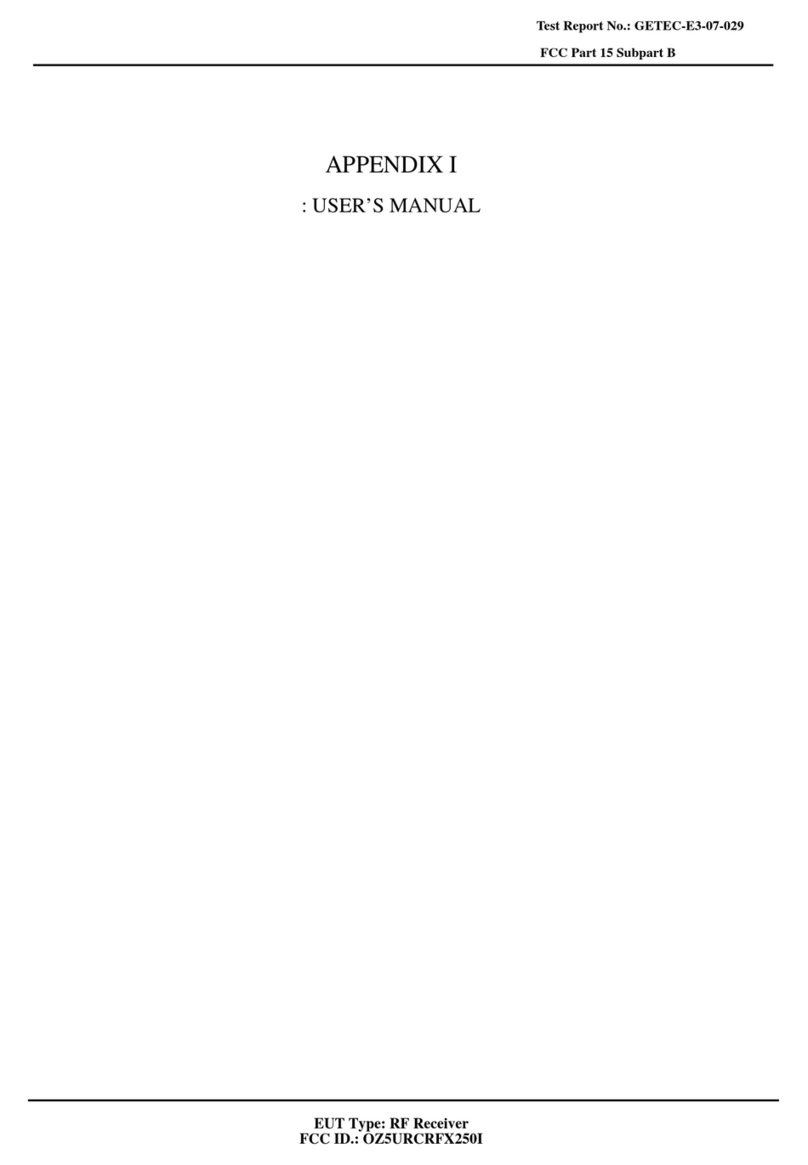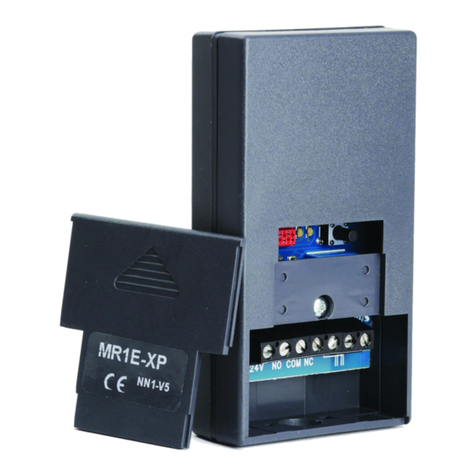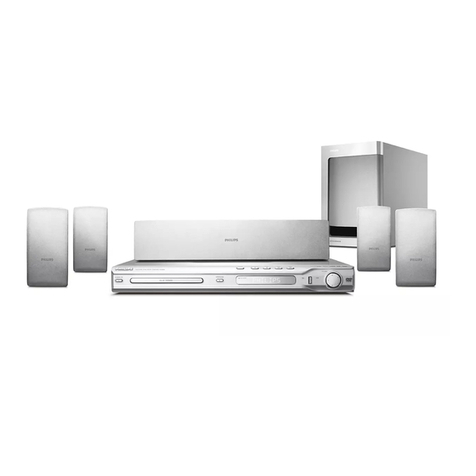Technicolor COM3000 User manual

w w w . t e c h n i c o l o r . c o m / m c s
Page 1
Technicolor COM3000
Integrator’s Manual

w w w . t e c h n i c o l o r . c o m / m c s
Page 2
Revision Record
Revision
Date
Revision Editor
Revision Description
Draft1
2/18
Angelo Peruch
1st draft
Draft2
4/25/18
Angelo Peruch
Added UL information in Sections 2.1 and 12
Added System lock feature
Added QAM20 section
5/14
Angelo Peruch
Added “disable flooding” in COM400 switch settings
6/6/18
Doug Strachota
Final Edits
10/8/19
MCS TEAM
Document review
Draft3
11/21/19
Angelo Peruch
Update COM400 section, graphics, get set, external sources,
tune all

w w w . t e c h n i c o l o r . c o m / m c s
Page 3
Contents
1Definitions...................................................................................................................................9
2Introduction ...............................................................................................................................12
2.1 Intended Usage ............................................................................................................................... 12
3COM3000 Product Overview....................................................................................................13
3.1 Additional Features......................................................................................................................... 15
3.2 Compatibility with Previous Hardware ........................................................................................... 16
3.3 Mechanical Overview...................................................................................................................... 16
3.4 COM400 Chassis.............................................................................................................................. 16
3.5 COM51 Card.................................................................................................................................... 18
3.6 COM51A.......................................................................................................................................... 19
3.7 QAM20 ............................................................................................................................................ 20
4Installation Overview ................................................................................................................21
4.1 System Connections........................................................................................................................ 21
..................................................................................................................................................................... 21
4.2 Pre-Installation................................................................................................................................ 21
4.3 Training and Support....................................................................................................................... 21
4.4 Required Tools ................................................................................................................................ 22
4.5 Site Survey....................................................................................................................................... 22
4.6 Distribution Networks..................................................................................................................... 23
4.7 Channel Lineup................................................................................................................................ 23
4.8 External Video Sources.................................................................................................................... 24
4.9 TV Compatibility.............................................................................................................................. 24
4.10 Installation Guidelines..................................................................................................................... 25
4.11 AT&T / DIRECTV Activation ............................................................................................................. 25
4.12 Component Assembly ..................................................................................................................... 26
4.13 Setting up Multiple Chassis............................................................................................................. 27
4.14 System Power Up ............................................................................................................................ 29
4.15 System startup LED Behavior .......................................................................................................... 29
Boot up........................................................................................................................................................ 29
4.16 LED Behavior after Boot up............................................................................................................. 30
5COM400 Chassis.......................................................................................................................31

w w w . t e c h n i c o l o r . c o m / m c s
Page 4
5.1 Accessing the COM400 User interface............................................................................................ 31
5.2 Port Definitions ............................................................................................................................... 32
5.3 Setting a Password.......................................................................................................................... 33
5.4 COM400 Software Update.............................................................................................................. 33
5.5 COM400 Settings for Multicast....................................................................................................... 34
5.6 IGMP Settings.................................................................................................................................. 35
5.7 Port Settings.................................................................................................................................... 36
5.8 Changing the Chassis Management IP address (OPTIONAL) .......................................................... 37
5.9 Save Changes to Running Configuration......................................................................................... 39
5.10 COM51 Card Discovery Issues......................................................................................................... 40
5.11 Debugging Tips................................................................................................................................ 40
..................................................................................................................................................................... 40
6The COM51 Web Interface.......................................................................................................41
6.1 User Password................................................................................................................................. 41
6.2 COM51 Licensing............................................................................................................................. 42
6.3 Overview Tab .................................................................................................................................. 44
6.3.1 QAM Summary........................................................................................................................ 45
6.3.2 Display Options ....................................................................................................................... 45
6.3.3 Channel Tuning Options.......................................................................................................... 46
6.3.4 Security Mode ......................................................................................................................... 47
6.4 Discover Page.................................................................................................................................. 49
6.4.1 Explanation of Discover Page Fields........................................................................................ 49
6.5 The Basic Channel Tune Screen....................................................................................................... 51
6.6 Advanced Tune................................................................................................................................ 52
6.6.1 Informational Status................................................................................................................ 55
6.7 Displaying COM3000 Status............................................................................................................ 63
6.8 Pairing Info ...................................................................................................................................... 64
6.9 TuneAll ............................................................................................................................................ 67
6.10 Help ................................................................................................................................................. 69
6.11 SysInfo............................................................................................................................................. 69
6.12 HealthInfo........................................................................................................................................ 70
6.13 Syslog............................................................................................................................................... 71

w w w . t e c h n i c o l o r . c o m / m c s
Page 5
6.14 EPG .................................................................................................................................................. 72
6.14.1 Guide.XML Overview............................................................................................................... 74
6.14.2 Getting Started with EPG ........................................................................................................ 75
6.14.3 EPG for IP Multicast Systems .................................................................................................. 78
6.14.4 EPG Customization and Channel Mapping.............................................................................. 78
6.14.5 EPG Editing.............................................................................................................................. 79
6.15 Welcome Screen ............................................................................................................................. 80
6.15.1 Welcome Screen Image Creation............................................................................................ 80
6.15.2 Uploading Welcome Screens to COM51................................................................................. 83
6.15.3 Adding Welcome Screens to Guide Data ................................................................................ 84
6.15.4 Disabling Welcome Screens .................................................................................................... 84
7QAM20......................................................................................................................................85
7.1 Accessing the QAM Page................................................................................................................. 85
7.2 QAM Software Version.................................................................................................................... 86
7.3 Updating QAM20 Software............................................................................................................. 86
7.4 QAM License Count......................................................................................................................... 86
7.5 Setting QAM Output Channels........................................................................................................ 87
7.6 Setting Unique RF output to a QAM index...................................................................................... 89
7.7 Setting the frequencies for a group of QAM carriers...................................................................... 90
7.8 Simultaneous QAM and Multicast IP Output.................................................................................. 91
7.9 QAM20 qamLog .............................................................................................................................. 93
7.10 QAM20 UDP ports........................................................................................................................... 93
7.11 Input of External Sources to QAM20 .............................................................................................. 93
7.12 Steaming Multi Program Transport Stream to QAM20 .................................................................. 93
8Vidplay Software.......................................................................................................................94
9Troubleshooting.........................................................................................................................95
9.1 Troubleshooting Common Problems .............................................................................................. 96
10 Preventing Pro:Idiom Key Loss ................................................................................................96
11 Transcoder Operations...............................................................................................................96
12 Receiverless HD ........................................................................................................................99
13 Syslog Server Setup...................................................................................................................99
14 Open Software Notification.....................................................................................................102

w w w . t e c h n i c o l o r . c o m / m c s
Page 6
Table of Figures
FIGURE 1-COM3000........................................................................................................................ 14
FIGURE 2COM400 CHASSIS.............................................................................................................. 16
FIGURE 3-COM51 CARD.................................................................................................................. 18
FIGURE 4-QAM20............................................................................................................................ 20
FIGURE 5-COM51 SYSTEM DIAGRAM.............................................................................................. 21
FIGURE 6-INSTALLATION OF THE QAM20 AND COM51.................................................................. 26
FIGURE 7–COM400 DIPSWITCH ACCESS PANEL.............................................................................. 27
FIGURE 8-CHASSIS ID DIPSWITCH.................................................................................................... 27
FIGURE 9-LED BEHAVIOR AT BOOT UP........................................................................................... 29
FIGURE 10 -OPERATIONAL LED BEHAVIOR...................................................................................... 30
FIGURE 11 -ETHERNET SWITCH INTERFACE ...................................................................................... 31
FIGURE 12 COM400 PORT STATE ..................................................................................................... 32
FIGURE 13 -NETWORK SWITCH PASSWORD....................................................................................... 33
FIGURE 14 COM400 SOFTWARE........................................................................................................ 33
FIGURE 15 COM400 SW UPDATE ..................................................................................................... 33
FIGURE 16 IGMP SETTINGS............................................................................................................... 35
FIGURE 17 -IGMP VLAN CONFIGURATION..................................................................................... 35
FIGURE 18 -COM400 PORT CONFIGURATION ................................................................................... 36
FIGURE 19 -COM400 IP CONFIGURATION ........................................................................................ 37
FIGURE 20 -ADD IP INTERFACE......................................................................................................... 37
FIGURE 21 –VLAN CONFIGURATION................................................................................................ 38
FIGURE 22 -COM400 SAVE RUNNING CONFIGURATION................................................................... 39
FIGURE 23 PASSWORD CHALLENGE................................................................................................... 41
FIGURE 24 -LOCK SCREEN ................................................................................................................ 41
FIGURE 25 -SYSINFO PAGE TUNER COUNT ....................................................................................... 42
FIGURE 26 -COM51 TUNER LICENSING............................................................................................ 43
FIGURE 27 -COM3000 OVERVIEW PAGE.......................................................................................... 44
FIGURE 28 -QAM SUMMARY............................................................................................................ 45
FIGURE 29 –ENCRYPTION SETTINGS ................................................................................................. 46
FIGURE 30 -CHANNEL SELECTION DROP DOWN................................................................................ 47

w w w . t e c h n i c o l o r . c o m / m c s
Page 7
FIGURE 31 -OUTPUT MODE............................................................................................................... 47
FIGURE 32 -MAJOR/MINOR CH OR IP AND PORT SETTINGS............................................................... 47
FIGURE 33 -BITRATE DISPLAY .......................................................................................................... 48
FIGURE 34 -SNR AND SIGNAL STRENGTH......................................................................................... 48
FIGURE 35 -COM51 DISCOVER PAGE ............................................................................................... 49
FIGURE 36 -COM51 BASIC TUNE SCREEN........................................................................................ 51
FIGURE 37 -ADVANCED TUNE SCREEN ............................................................................................. 52
FIGURE 38 -"INFO"SECTION OF THE ADVANCED EDIT PAGE ............................................................ 55
FIGURE 39 -NETWORK AND FREQUENCY INDEX................................................................................ 56
FIGURE 40 -LED CONTROL............................................................................................................... 57
FIGURE 41 -CAM LOG INTERFACE.................................................................................................... 58
FIGURE 42 -CAM LOG REPORT.......................................................................................................... 58
FIGURE 43 -RESET INTERFACE .......................................................................................................... 59
FIGURE 44 -FILE TRANSFER INTERFACE............................................................................................ 59
FIGURE 45 -USER CONFIG INTERFACE............................................................................................... 60
FIGURE 46 -GET/SET USAGE............................................................................................................. 62
FIGURE 47 -DIRECT TUNE INTERFACE.............................................................................................. 63
FIGURE 48 -COM51 PAIRING INFO PAGE.......................................................................................... 64
FIGURE 49 MULTICARD SOFTWARE UPGRADE................................................................................... 66
FIGURE 50 -TUNE ALL ...................................................................................................................... 67
FIGURE 51 -HELP TAB....................................................................................................................... 69
FIGURE 52 –SYSINFO TAB................................................................................................................. 69
FIGURE 53 –COM51 HEALTH INFO PAGE ......................................................................................... 70
FIGURE 54 -SYSLOG EXAMPLE.......................................................................................................... 71
FIGURE 55 –SYS INFO EPG INFORMATION........................................................................................ 72
FIGURE 56 -IPG SETUP PAGE............................................................................................................ 74
FIGURE 57 -COM3000 EPG PAGE.................................................................................................... 75
FIGURE 58- COM51 EPG LOAD ........................................................................................................ 77
FIGURE 59 MULTICAST GUIDE.XML................................................................................................. 78
FIGURE 60 -EPG CHANNEL............................................................................................................... 79
FIGURE 61 WELCOME PAGE POWERPOINT SLIDE .............................................................................. 80
FIGURE 62 -WELCOME SCREEN IMAGE CREATION............................................................................ 80
FIGURE 63 -WELCOME SCREEN SETTINGS USING MICROSOFT PAINT ............................................... 81

w w w . t e c h n i c o l o r . c o m / m c s
Page 8
FIGURE 64 -CORRECTLY SIZED WELCOME SCREEN IMAGE............................................................... 82
FIGURE 65 UPLOAD FILE TO COM51 TFTP....................................................................................... 83
FIGURE 66 -UPLOAD WELCOME SCREEN IMAGE TO EPG.................................................................. 83
FIGURE 67 -ADDING WELCOME SCREEN TO EPG AND PSIP............................................................. 84
FIGURE 68 -VERIFY WELCOME SCREEN IS STREAMING ..................................................................... 84
FIGURE 69 -QAM SUMMARY HYPERLINK......................................................................................... 85
FIGURE 70 -QAM TAB IP ENTRY ...................................................................................................... 85
FIGURE 71 -QAM SOFTWARE AND LICENSE COUNT ......................................................................... 86
FIGURE 72 -SETTING QAM OUTPUTS ............................................................................................... 87
FIGURE 73 QAM TABLE .................................................................................................................... 88
FIGURE 74 -CHANGING A SINGLE QAM OUTPUT.............................................................................. 89
FIGURE 75 -INDIVIDUAL QAM OUTPUT CHANGE ............................................................................. 89
FIGURE 76 -CHANGING OUTPUTS CHANNELS ON A GROUP OF QAMS.............................................. 90
FIGURE 77 -QAM GROUP OUTPUTS.................................................................................................. 90
FIGURE 78 -QAM20 ALTERNATE IP FIELD....................................................................................... 91
FIGURE 79 -COM51 RESET............................................................................................................... 95

w w w . t e c h n i c o l o r . c o m / m c s
Page 9
1Definitions
Term
Definition
Admin PC
A PC is required for initial setup and configuration. It is highly recommended to set up
remote access to the COM3000 system for monitoring and maintenance post installation.
This can be accomplished via several methods:
A PC on site, connected to the internet running Team Viewer or a similar remote desktop
program. PC will need to be on the same IP subnet as the COM3000 system
VPN router set up for remote access via a Virtual Private Network
ATSC
Advanced Television Systems Committee. An international organization developing
voluntary standards for digital television. Typically used to describe terrestrial off air
broadcast TV standards. ATSC Tuner describes a TV capable of receiving digital off-air
broadcasts.
http://atsc.org/
ATSC-8
This is a device previously provided by Technicolor to provide ATSC off air television signals
to the COM3000. It is configured and controlled through the COM3000 web interface.
Depending on configuration it can deliver 8 program channels or 8 complete ATSC8
broadcasts including all sub channels in the carrier.
COM3000
This describes the Technicolor system consisting of a COM400 chassis, COM51 or COM51A
cards and QAM20 modulators. Replaced previous product COM2000
COM51 & COM51A
Receiver Cards
Receiver cards for the COM3000 system. Replaced previous product version COM46 /
Com46A.
COM400 Chassis
This device houses the COM51 and QAM20 components in a COM3000 system. All
video traffic is routed through the two 10 Gigabit and two 1 Gigabit Ethernet (GbE) ports
on the front of the chassis and to the QAM20 slots. System management and control
can be done by connecting a computer to any of the ethernet ports on the front panel.
Replaced previous product version COM360
QAM20
A circuit board that installs in the upper left side of a COM400 Chassis. It converts the
COM51’s IP-packetized streams to QAM-modulated RF for distribution throughout a
property. The board provides up to 16 QAM carriers and is software upgradeable in groups
of two QAMS for a maximum of 48 QAM carriers.
SWQAM2
The SWQAM2 is a software key that will enable 2 QAM channels per key on a QAM20 card.
By purchasing 3 SWQAM2 keys a QAM20 can be expanded to 12 QAM channels.
DSWiM 30
AT&T / DIRECTV SWM. One DSWiM 30 will provide signal to a COM51 card when tuning
more than 8 channels
EAS
Emergency Alert Systems can be interfaced with the COM3000 to stream emergency
notifications to all QAM channels. Similar to this a local message can be created and played
via a PC and VLC or a ZyCast Media Server.
https://www.fcc.gov/encyclopedia/emergency-alert-system-eas
Edge QAM
In a typical installation, the COM51 cards will be configured to stream to a QAM20
modulator.

w w w . t e c h n i c o l o r . c o m / m c s
Page 10
GIGe
Gigabit Ethernet High speed Ethernet standard for transmitting data at one gigabit per
second. All switches in the GIGe (video) network must be rated to pass this level of traffic.
IGMP
Internet Group Management Protocol. Used by Ethernet Switches and end devices to
manage multicast video on IP networks.
HD
High Definition
Hot-swappable
The unit or device this term describes may be added to, removed from, or replaced
within the system it is a part of without powering anything down.
MPEG
Moving Pictures Experts Group - A working group of ISO/IEC with the mission to develop
standards for coded representation of digital audio and video and related data.
Most commercial and some residential TVs support MPEG4 standards. All AT&T /
DIRECTV HD signals are MPEG4 contained in a MPEG2 transport stream. Many residential
and some older commercial TVs will only support MPEG2 signals and will require
transcription from MPEG4 to MPEG2, or the use of a setback box like the Technicolor
DCI401MCS.
http://mpeg.chiariglione.org/
PC/VLC
The COM3000 can accept streaming video from a networked PC running VLC, an open
source video software.
http://www.videolan.org/vlc/index.html
PID
Packet Identification. A 13-bit field in the header of every 188-byte MPEG2 transport
packet.
Pro:Idiom
Pro:Idiom is an industry accepted digital rights management encryption technology for
video signals broadcast in commercial establishments such as hotels, dormitories and
hospitals. All major programmers have accepted Pro:Idiom as an encryption method to
secure programming. Only televisions or set-back boxes with built in Pro:Idiom
encryption system decoders will be able to decrypt the signal.
http://www.zenith.com/wp-content/uploads/2013/05/ProIdiom_Overview_2010-10-
08.pdf
Pro:Idiom Mobile
A version of Pro:Idiom which is software based and can be decrypted using an approved
and licenses software player.
Property
Distribution
Network
This network, set up and maintained by the system operator or property owner,
distributes television signals via RF or IP technology. Traditional analog RF plants often
are in need of repairs and upgrades before they will pass digital HD programming. RF
levels and signal to noise ratios (Modulation Error Rate) should be tested to industry
standards. IP systems require technicians proficient in IP switch configurations,
specifically multicast networks utilizing Internet Group Management Protocols (IGMP).
PSIP
Program and System Information Protocol. Signals included in a digital TV signal define
the display channel. For example, an off-air channel may be broadcast on UHF ch 38 but
the station call letters are ch 7. PSIP data instructs the TV to display a virtual channel 7 on
the TV rather than the physical channel 38. PSIP data also includes current and future
programming information.
http://www.atscforum.org/

w w w . t e c h n i c o l o r . c o m / m c s
Page 11
Satellite
Distribution
Network
This network consists of the dish, LNB and associated equipment necessary to provide
KA/KU band satellite signals to the COM3000. The COM3000 requires a SWiM signal to
each card proportional to the number of tuners desired. It is assumed that installation
technicians have adequate expertise and proper test equipment required to install the
distribution system to AT&T / DIRECTV specifications.
SD
Standard Definition
SWiM Switch
Single Wire Multi-switch –An AT&T / DIRECTV module used for the distribution of
satellite signals.
SWQAM2
The SWQAM2 is a software key that will enable 2 QAM channels per key on a QAM20
card. By pruchasing 3 SWQAM2 keys a QAM20 can be expanded to 12 QAM channels.
System
Integrator
The person or company that performs the onsite installation.
System
Operator
The company or organization that typically holds the “right of entry” and is responsible
for installation and all onsite support on a daily basis.
Transcryption
The process by which the COM 1000 system converts content streaming from AT&T /
DIRECTV ’s conditional access system to Pro:Idiom encrypted video.
ZyCast Media
Server
The ZyCast media server converts video and audio from HDMI or Composite video and
creates an IP stream that can be modulated on the RF network via the QAM 6.
http://www.zycast.com.tw/

w w w . t e c h n i c o l o r . c o m / m c s
Page 12
2Introduction
This document describes the Technicolor COM3000 System and related configuration procedures.
It is recommended that you read through the entirety of the manual before working with the system,
as it contains some important pointers that may come in handy during setup and maintenance.
2.1 Intended Usage
COMMERCIAL USE This product is designed to go into areas that are not accessible to the public
at large and are not for home use. Technicolor COM3000 Products provide Head-End systems for
distribution solutions for the AT&T / DIRECTV Commercial and Lodging and Institutions (L&I)
markets
.

w w w . t e c h n i c o l o r . c o m / m c s
Page 13
3COM3000 Product Overview
A COM3000 system consists of the following three components:
➢COM400 chassis
➢COM51 or COM51A tuner cards (maximum of 6 per chassis)
➢QAM20 modulator (maximum of 2 per chassis)
The COM3000 is the next evolution of the Technicolor Multiclient Solution product line. It builds
on the successful COM2000 system with additions of several new features.
➢COM400
oChassis includes internal layer two switch supporting IGMP
oTwo 1Gb and two 10Gb ethernet ports
➢COM51
oAbility to tune up to 23 DIRECTV channels
oSupports Pro:Idiom Mobile encryption
oSupports manufacturer specific AES encryption for use with external devices
oAutomatic Software Upgrades via Technicolor Server
➢QAM20
oOutputs 16 QAM carriers, software upgradable to 48 QAM carriers.
oFull 38.8 Mbps QAM capacity
oNew easy to use setup
Configured with 6 COM51 receivers and one QAM20 a COM3000 can tune up to 138 AT&T /
DIRECTV channels.
➢Each COM51 card can receive up to 23 AT&T / DIRECTV channels.
➢COM51 cards can be incrementally licensed to tune between 8 (base package) and 23 channels in
increments of one channel per software upgrade.
➢QAM20 is capable of 48 QAM carrier outputs incrementally licensed from 16 (base package) to 48
QAM carriers in groups of 2 carriers per software upgrade.
➢The channels are routed to an internal QAM20 modulator for RF output. In addition to the RF
output the COM51 chassis provides two 10 gigabit and two 1 gigabit ethernet ports.

w w w . t e c h n i c o l o r . c o m / m c s
Page 14
The COM3000 system is shown below in Figure 1.
Figure 1 - COM3000
➢The original AT&T / DIRECTV broadcast video encoding format is preserved, and the output
transport stream is encrypted with the Pro:Idiom digital rights management (DRM) by default.
Other DRM selections such as AES and Pro:Idiom Mobile are supported.
➢Multiple COM400 chassis can be connected in order to provide more than 138 output channels. Up
to 16 chassis can be connected in the same system.
The COM51 receiver cards are controlled and managed via an Ethernet connection within the
COM400 chassis.
➢The COM51 card includes a built-in web interface and can be configured using a web browser.
➢To view high definition video from the COM3000 a TV or set top box equipped with decryption
technology must be used.
➢Standard definition channels may be distributed in-the-clear.
QAM 20s
COM51
COM 400 Chassis

w w w . t e c h n i c o l o r . c o m / m c s
Page 15
3.1 Additional Features
In addition to high quality AT&T / DIRECTV programming, the COM3000 system offers
additional powerful features:
➢Optional Mediatune software upgrade offers switched matrix control capabilities for public space
environments.
➢Internal “home screen” channels can be configured to stream static image message screens direct
from the COM3000 system. No additional equipment required.
➢Vidplay utilizes a free program developed by Technicolor that will stream a MPEG2 transport
stream file from a connected PC (not provided) to the Technicolor QAM20 modulator for locally
originated video programming.
➢External content sources such as outboard transcoders and video encoders can also be streamed
to the Technicolor QAM20 Modulator.
➢An electronic program guide (EPG) that is fully customizable to system channel lineup and local
programming. PSIP data will pass to televisions and “map” the channels without intervention. (PSIP
interpretation is TV dependent, not all TVs respond to PSIP in the same manner. Test the TVs
before installing.
➢Guide.XML works in conjunction with Technicolor set-top boxes to provide an interactive program
guide (IPG).
➢Interfaces with Emergency Alert Systems (EAS). Capable of sending locally originated streams to all
video channels for site specific emergency broadcast. (Only available on systems utilizing the
Technicolor QAM20 modulator).
➢Low power consumption. Typically, a fully loaded chassis draws <200 watts.

w w w . t e c h n i c o l o r . c o m / m c s
Page 16
3.2 Compatibility with Previous Hardware
➢COM400 chassis will support COM46 cards but not QAM6.
➢COM51 Cards will work in COM360 Chassis
oA COM46 will only show the first 12 QAM carriers on the QAM20.
oA COM360 can only stream 1 Gb to a QAM20.
3.3 Mechanical Overview
The following sections contain a brief overview of the devices that you will be interacting with
along with the associated hardware. The intent is to give you a working knowledge of how the
system operates under normal circumstances.
3.4 COM400 Chassis
Figure 2 below is a front and rear view of the COM400 chassis.
Figure 2 COM400 Chassis
➢Requires 3 RU rack space.

w w w . t e c h n i c o l o r . c o m / m c s
Page 17
➢MTFB (Mean Time Before Failure) >43,800 hours (five years).
➢Chassis number assigned via dipswitch beneath top cover access panel.
➢Ventilation flows from front air vents to rear exhaust fans. Maintain adequate space for free air
flow through system.
➢Chassis has slots to accept six COM51 or COM51A and two QAM20 cards.
➢COM51, COM51A and QAM20 cards are assigned default IP addresses per location in chassis and
chassis number.
➢10 Gigabit Ethernet switch configurable for Multicast Filtering, IGMP Snooping.
Equipped with 4 ethernet ports:
➢Two 10 gigabit ports.
➢Two 1 gigabit ports (Do not connect your external Managed Ethernet switch to the 1 gigabit port.
The 1 gigabit ports are connected internally to an unmanaged 2 port switch.)
➢All ports support auto-negotiate per IEEE802.3-2015 specification. (Any Network interface device
will connect to any port).

w w w . t e c h n i c o l o r . c o m / m c s
Page 18
3.5 COM51 Card
The COM51 card, shown in Figure 3 below, is a customized AT&T / DIRECTV receiver with a
built-in smart card and has been specifically designed to meet the unique requirements of the
Lodging and Hospitality markets.
➢The COM51 base configuration can receive up to 8 HD or SD AT&T / DIRECTV channels. Optional
software upgrades increase the capacity to 23 channels.
➢The COM51 removes the AT&T conditional access encryption and adds Pro:Idiom or other content
protection DRM.
➢The output from the card can be delivered to a QAM20 modulator or chassis ethernet connections
via the COM400 chassis’ internal 10 gigabit Ethernet network.
Figure 3- COM51 Card
➢Web server user interface
➢Supports 8 to 23 tuners (licensed in one-tuner increments)
➢Requires a DSWiM input to both RF connectors for full 23 channel configuration
(one DSWiM30 per COM51 card).
➢Hot-swappable
➢Recessed reset button
➢LED indicators
➢Compatible with legacy COM360 chassis and QAM6 modulators with limitations
➢Manual software updates via internal TFTP server.
➢Queries Technicolor update server for software updates at bootup and at daily
intervals, downloads and installs software automatically.
oServer will instruct COM51 to complete update at a prespecified time in
early AM hours.
➢REST monitoring to AT&T/DIRECTV server is enabled as default.
➢REST Monitoring and software query can be disabled via software license.
➢Dual IP allows for local management via the default IP and will allow DHCP
address assignment for COM51.

w w w . t e c h n i c o l o r . c o m / m c s
Page 19
3.6 COM51A
COM51A is a specially configured COM51 card which works only with the Technicolor NTSC-8
analog modulator.
➢It will not stream IP video to a QAM or ethernet port.
➢Only the NTSC-8 will receive video data from a COM51A.
➢A COM51A is software upgradable to a standard COM51.
➢Note: When a COM51A is upgraded a COM51, any COM51A tuner licenses will be converted to
COM51 tuner licenses (which requires tokens).

w w w . t e c h n i c o l o r . c o m / m c s
Page 20
3.7 QAM20
Figure 4 - QAM20
The QAM20, shown above in Figure 4 is an Edge QAM256 modulator capable of outputting up to
48 QAM carriers.
➢QAM20 ships from the factory authorized for 16 QAM carriers. The unit is upgradable in 2 QAM
increments via optional software license (SWQAM2) to a maximum of 48 QAM output carriers.
➢Depending on the DIRECTV channel bit rate, each QAM carrier may support up to three HD or eight
SD program channels.
➢Accepts IP input from:
oCOM51 Card
oCOM46 Card
oExternal MPEG2 transport stream (.TS)
➢Each QAM is individually agile and able to output to any carrier frequency in a 128-channel range
oModeLow enables carriers 1 to 128 (57MHz to 819MHz) output
oModeHigh enables carriers 26 to 158 (237MHz to 999MHz) but not 95 to 99
➢New User interface makes configuring channel line ups easier than the previous QAM6.
➢QAM Licensing is the responsibility of the Product Distributor.
Other manuals for COM3000
1
Table of contents
Other Technicolor Receiver manuals
Popular Receiver manuals by other brands
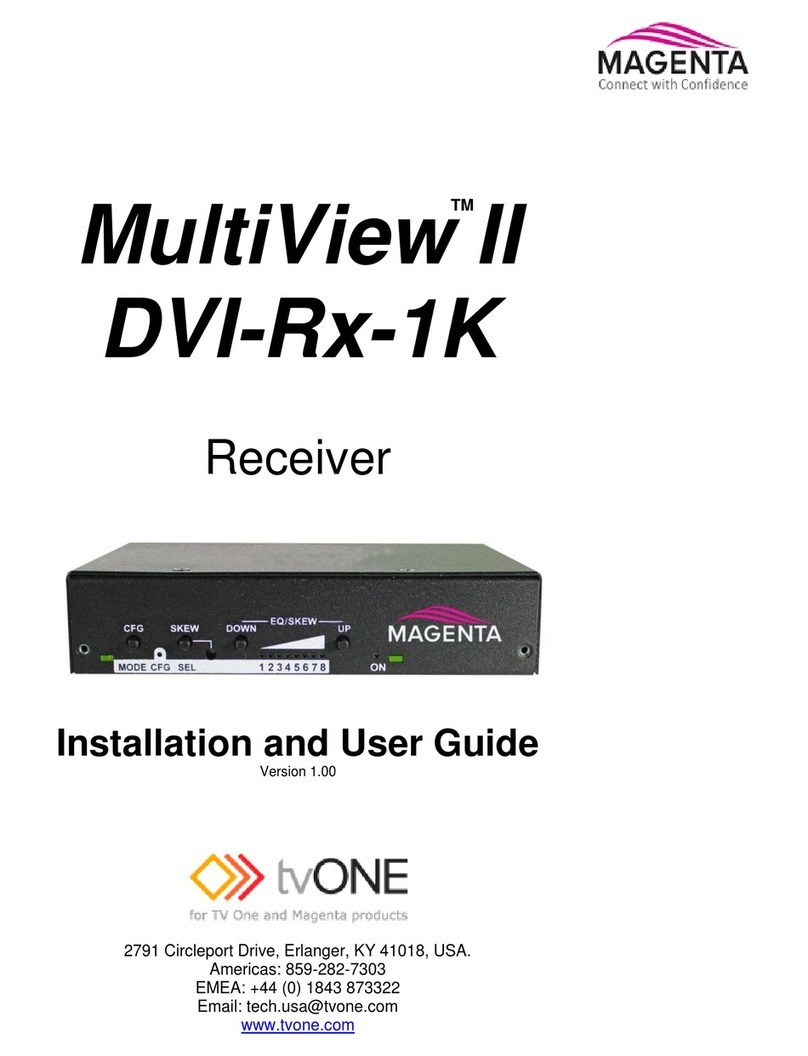
Magenta
Magenta MultiView II DVI-Rx-1K Installation and user guide

City Theatrical
City Theatrical 5906 user manual

AMG
AMG AMG3788BRN-DR-SF instruction manual
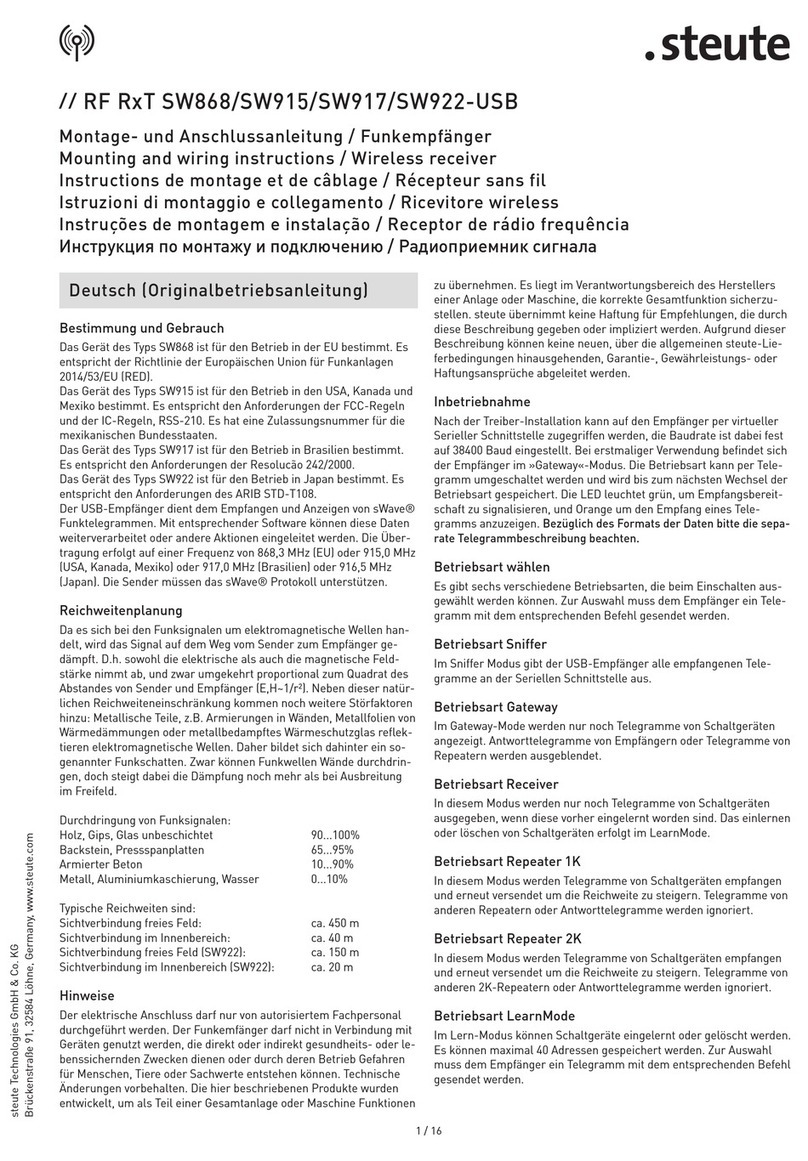
steute
steute RF Rx SW868-USB Mounting and wiring instructions
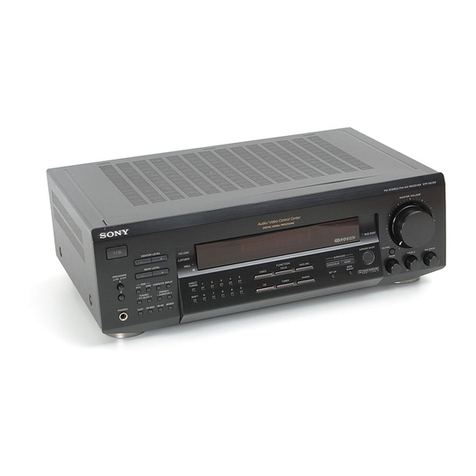
Sony
Sony STR-DE325 User Manual Addendum operating instructions
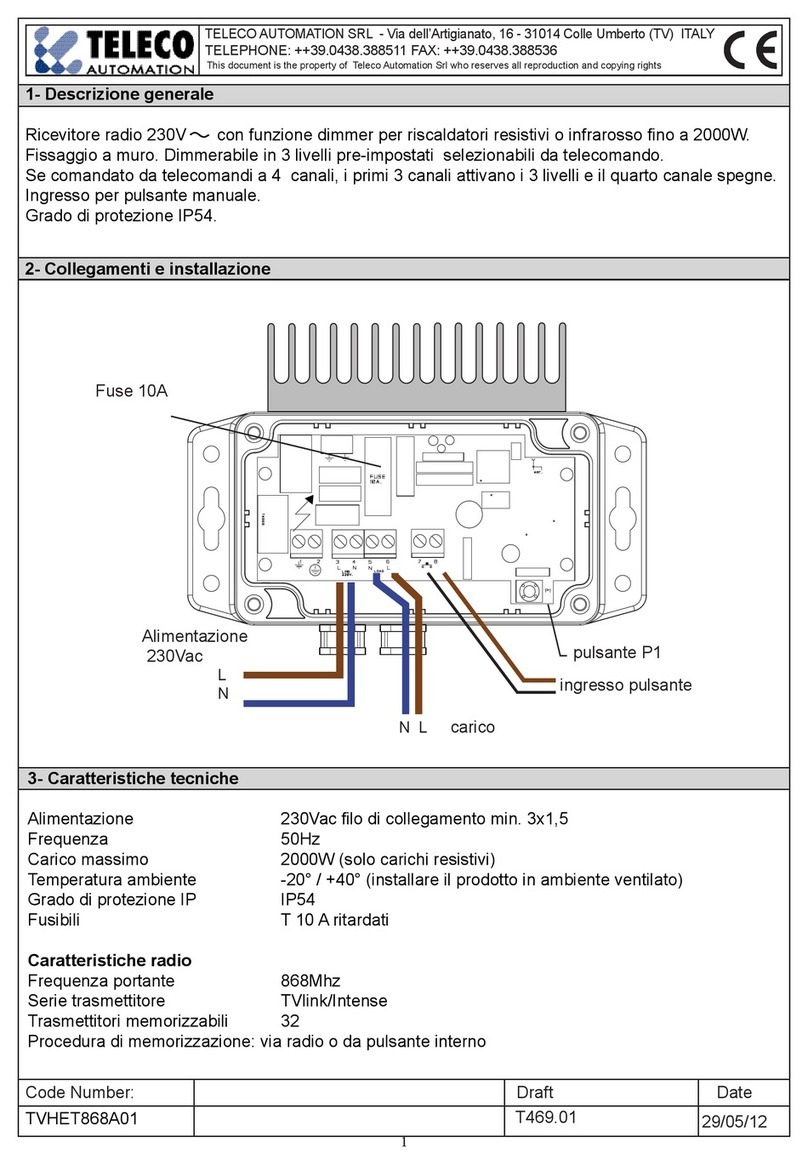
Teleco
Teleco TVHET868A01 manual
